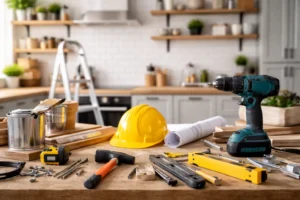I still remember that chill in the air one February night when I heard the first gentle grunting from Molly. I scrambled to my toolkit and realized I hadn’t restocked last season’s supplies. That shaky moment taught me that having reliable goat supplies on hand before kidding starts is non-negotiable.
Your goat birthing kit is one of the most important collections of goat supplies you’ll ever build. It’s your first line of defense when labor begins at 2 a.m. or when a kid struggles to breathe. Over the years, I’ve refined mine, and in this post I want to share everything I’ve learned—so you won’t be scrambling in the barn.
Goat Birthing Kit: The Core You Can’t Be Without
The heart of this post: your goat birthing kit. Think of this as your “go or die” chest for kidding season. Here are the contents I build into every kit before the first due date.
Must-have items in my goat birthing kit
- Clean towels and rags (lots of them) — for drying kids, cleaning the doe, and keeping the stall tidy
- OB lubricant (sterile) — to ease internal assistance when needed
- Long OB / shoulder-length gloves — for protection and hygiene when helping internally
- Iodine or chlorhexidine solution — for dipping the umbilical cord to prevent infection
- Scissors + cotton or dental floss string — to tie or trim umbilical cords
- Bulb syringe or nasal aspirator — to clear mucus from newborn’s mouth or nose
- Digital thermometer — to monitor doe’s and kids’ temperature
- Flashlight or headlamp (with extra batteries) — births don’t care about daylight
- Colostrum (fresh, frozen, or powdered substitute) — in case the kid can’t nurse right away
- Feeding bottles and nipples (Pritchard or similar) — for weak or rejected kids
- Heat source / blanket / warming pad — to warm weak or chilled kids
- Molasses or electrolyte drink — for giving mom a post-birth energy boost
- Backup gloves, string, small containers (e.g. Dixie cups), sanitizing wipes or alcohol
- Veterinarian contact info, record pad, pen
This kit is your safety net when things don’t go exactly as nature intended.

Goat Care: From Labor Through Baby Bonding
When labor begins, your attention shifts from preparation to goat care—for both doe and kid. In those hours, how you act matters more than how many tools you have.
For the Doe
- Provide a clean, quiet kidding stall with fresh bedding
- Keep the environment draft-free, but ventilated
- Offer warm water (optionally with molasses or electrolytes)
- Wash your hands and wear gloves before any contact
- Stay calm, observe, and only intervene when clearly necessary
For the Kid
- Dry immediately with towels
- Dip cord in iodine after trimming
- Clear airway with bulb syringe if needed
- Warm with blanket or heat source
- Ensure first nursing (or feed colostrum) within first hour
- Take weight, monitor breathing, and record time
Goat care after birth is a balance of attentiveness and restraint — intervening when necessary but minimizing stress on mom and kid.
Goat Farm: Organizing the Backdrop for Success
Your goat farm setup plays a huge role in how smoothly kidding goes. My barn layout and protocols evolved through trial and error. Here’s how I set up my farm for success:
- Dedicated kidding pen or “jugs”: private, secure pens where mom and kids can bond undisturbed
- Clean zone for tools: a small area or shelf near the kidding pen to store and organize your kit
- Lighting and power: reliable lighting (LED, motion sensors) plus backup power or battery lights
- Temperature control: maintain barn and pens at safe temps — around 45–55°F for adults, warmer for kids
- Traffic flow: keep high-traffic areas separate from kidding areas to reduce disturbances
- Sanitation stations: footbaths, handwashing, tool sanitizing areas
- Record area: a small board or notebook near the pens to log births, weights, complications
Design your goat farm with kidding season in mind. The smoother your layout, the less panic when things get hectic.
Birthing Tools: Old School Essentials and Smart Upgrades
The distinction between a toolbox and a birthing toolbox lies in the birthing tools you carry. Some are simple and timeless; others are modern upgrades. Below is how I mix and match.
Traditional Birthing Tools (Evergreen)
- OB gloves, lubricant, towels, scissors, string
- Bulb syringe, iodine, flashlight
- Feeding bottles, colostrum packs, blankets
These are inexpensive, reliable, and essential whether or not you have power or gadgets.
Smart / High-Tech Birthing Tools
- Wireless barn cameras — monitor labor remotely
- Digital thermometers with app sync — watch temp drops without disturbing the doe
- Kidding sensor collars / monitors — detect contractions or movement
- Infrared temperature gun — quick, non-contact warmth checks
- Digital kid scale (syncs to phone) — automates weight tracking
- Heated water or warmers for bottles or electrolyte mixtures
- Portable ultrasound scanner — to check kid position or pregnancy early
Using modern birthing tools boosts your awareness and gives peace of mind, especially when managing multiple does. But don’t toss your basic tools — they’ll save you when tech fails.
Goat Farming: Layering Tradition with Innovation
In my journey with goat farming, I’ve found that success doesn’t come from choosing 100% traditional or 100% high-tech. The best system is a hybrid one.
For example:
- I keep OB gloves, lube, scissors, and iodine in the kit (traditional), but also carry a Bluetooth thermometer and baby scale (modern).
- I still lay out fresh towels and blankets, but use a barn camera to monitor without lurking in the pen.
- When power goes out, I fall back on my flashlight and backup batteries.
This layering means I’m never stuck. Whether off-grid or semi-automated, I have what I need at hand for goat farming success.

Goat Barn: Where Birth Happens (and Preparation Matters)
The goat barn is more than four walls — it’s your birthing theater. How you set it up can make or break your kidding season.
Essential features in my goat barn:
- Dedicated kidding area: pens with solid walls or partitions
- Safe, secure lighting: motion-activated LED strips or low-light LEDs
- Temperature zones: warmer corners or heat lamps for kids, cooler area for does
- Hooks and baskets: hang towels, gloves, tools, lube within arm’s reach
- Rubber mats or absorbent bedding: reduce slipping and improve cleanliness
- Easy cleaning access: doors wide enough, flooring that’s easy to sweep or hose
- Backup light sources: battery lanterns, headlamps in multiple spots
Every inch in your goat barn should be intentional. In the dark, you don’t want to fumble across equipment or trip over hoses.
Goat Tools: Your Trusted Companions in Kidding
When I say goat tools, I mean every item—big or small—that helps a birth go smoothly. They’re your companions on the cold nights, the long days, and the surprise kid emergencies.
Here’s how I categorize and pack my goat tools:
| Category | Tools | Why I Always Keep Them Ready |
|---|---|---|
| Hygiene & Safety | Gloves, sanitizer, iodine | Prevent infections, maintain biosecurity |
| Assistance | OB lubricant, long gloves, scissors, string | To reposition kids or assist when needed |
| Newborn support | Bulb syringe, towels, heat blanket | For breathing, drying, and warming |
| Monitoring | Thermometer, scale, camera | To track vital signs and labor progress |
| Feeding | Bottles, nipples, colostrum | For weak or non-nursing kids |
| Energy support | Molasses, electrolytes | Quick boosts for doe and kids post birth |
| Lighting | Flashlight, headlamp, backup batteries | Because birth rarely happens in daylight |
I pack these in a sturdy tote and label each section—one glance inside tells me exactly where I am.
Final Thoughts: Why Your Goat Birthing Kit Matters

Your goat birthing kit is more than a set of supplies. It’s a safety net, a gesture of care, and a confidence boost when things go sideways.
Goat births can be unpredictable. But with the right goat supplies, birthing tools, organization in your goat barn, and a good balance of tradition and smart gear, you’ll be ready whether the doe insists on an early delivery or the cold wind howls outside.
Every season, I open that bin, check every item, recharge batteries, and mentally walk through every possible scenario. Because when that first kid steps out into the world, I want every variable in my favor.
FAQs
A goat birthing kit should include gloves, towels, lubricant, iodine, scissors, bulb syringe, bottles, and colostrum. These ensure safe delivery and newborn care.
Start gathering supplies at least one month before your does are due. That gives you time to restock and sterilize tools.
Iodine disinfects the umbilical cord, preventing bacteria from entering and causing infection in newborn kids.
Yes, especially in cold weather. Use a safe, low-watt lamp to keep kids warm without overheating or fire risk.
Wireless cameras, smart thermometers, and sensor collars help monitor labor remotely and alert you to early signs of kidding.
Dry the kids, dip cords in iodine, ensure they nurse or drink colostrum, and give the doe warm water with electrolytes to recover.
After each birth, wash towels, disinfect tools, replace used items, and store everything in a sealed tote for next time.













